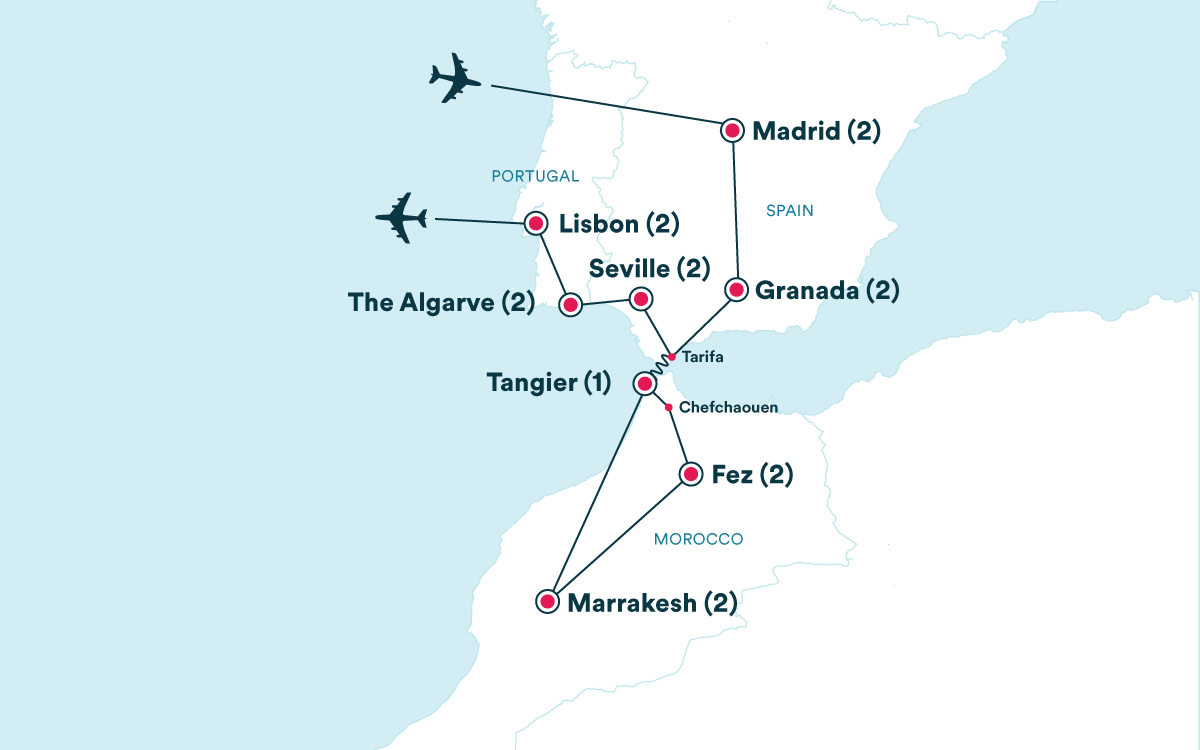Travel to Spain, Portugal, and Morocco: Exploring Spain, Portugal, and Morocco is a journey through diverse landscapes, rich histories, and vibrant cultures. These neighboring countries offer travelers a blend of Mediterranean charm, Atlantic vistas, and Saharan mystique. From ancient cities to breathtaking natural wonders, this itinerary will guide you through 10 must-see destinations that capture the essence of these incredible regions.
Travel to Spain, Portugal, and Morocco: Barcelona, Spain: The Heart of Catalonia
Barcelona, the capital of Catalonia, is a city that beautifully combines Gothic architecture with modernist masterpieces. La Sagrada Família, designed by the famous architect Antoni Gaudí, is an iconic symbol of the city and a must-visit. Stroll down La Rambla, a bustling street filled with shops, cafes, and street performers, or explore the Gothic Quarter with its narrow medieval streets and hidden gems. For art lovers, the Picasso Museum offers a deep dive into the works of one of the most influential artists of the 20th century. Don’t forget to relax at Park Güell, another Gaudí creation, offering panoramic views of the city.
Travel to Spain, Portugal, and Morocco: Lisbon, Portugal: The City of Seven Hills
Lisbon, the capital of Portugal, is a city of charming neighborhoods, each with its own unique character. Start your journey in Alfama, the oldest district, known for its narrow streets, traditional Fado music, and the imposing São Jorge Castle. Head to Belém to explore the Jerónimos Monastery and the Tower of Belém, both UNESCO World Heritage sites. The Belém area is also home to the famous Pastéis de Belém bakery, where you can try the original Pastéis de Nata (custard tarts). Don’t miss a ride on the iconic Tram 28, which winds its way through some of Lisbon’s most picturesque areas.
Marrakech, Morocco: The Red City
Marrakech, known as the Red City due to its distinctive red sandstone buildings, is a vibrant blend of old and new. The medina, a UNESCO World Heritage site, is a labyrinth of narrow streets filled with souks (markets) where you can shop for spices, textiles, and handicrafts. Visit the stunning Bahia Palace, with its intricate tilework and lush gardens, or the Koutoubia Mosque, the largest mosque in Marrakech. The Jardin Majorelle, once owned by fashion designer Yves Saint Laurent, is a serene oasis of exotic plants and vibrant colors. At the heart of the city is Jemaa el-Fnaa, a bustling square that comes alive at night with food stalls, musicians, and entertainers.
Seville, Spain: The City of Flamenco
Seville, the capital of Andalusia, is a city steeped in history and culture. The Seville Cathedral, one of the largest Gothic cathedrals in the world, is home to the tomb of Christopher Columbus. Adjacent to the cathedral is the Giralda, a former minaret converted into a bell tower, offering stunning views of the city. The Real Alcázar, a royal palace originally developed by Moorish Muslim kings, is a masterpiece of Mudéjar architecture. Seville is also the birthplace of flamenco, and a visit to a traditional flamenco show is a must. The city’s vibrant Triana neighborhood is a hub of flamenco culture, known for its pottery and lively atmosphere.
Porto, Portugal: The City of Bridges
Porto, located along the Douro River in northern Portugal, is known for its stately bridges, wine cellars, and historic architecture. The Ribeira district, a UNESCO World Heritage site, is a picturesque area with narrow, winding streets and colorful buildings. Visit the famous Livraria Lello, one of the most beautiful bookstores in the world, and inspiration for J.K. Rowling’s Harry Potter series. Cross the Dom Luís I Bridge for stunning views of the city and the river. Porto is also the birthplace of Port wine, and a tour of the wine cellars in Vila Nova de Gaia is essential for any wine enthusiast.
Granada, Spain: The Jewel of Andalusia
Granada, nestled at the foot of the Sierra Nevada mountains, is best known for the Alhambra, a sprawling palace and fortress complex that is a UNESCO World Heritage site. The Alhambra is a stunning example of Moorish architecture, with its intricate tilework, grand halls, and beautifully landscaped gardens. The Generalife, the summer palace of the Nasrid rulers, offers breathtaking views of the city and the surrounding mountains. The Albayzín district, with its narrow, winding streets, whitewashed houses, and traditional tea houses, provides a glimpse into Granada’s Moorish past. Don’t miss the Sacromonte neighborhood, known for its cave houses and vibrant flamenco shows.
Sintra, Portugal: A Fairytale Town
Just a short drive from Lisbon, Sintra is a town straight out of a fairytale. The Pena Palace, perched on a hilltop, is a colorful mix of Gothic, Renaissance, and Moorish architectural styles. The palace’s park, with its winding paths, exotic plants, and hidden grottoes, is a delight to explore. Another must-see is the Quinta da Regaleira, a grand estate with a mysterious initiation well, underground tunnels, and lush gardens. The Moorish Castle, with its ancient walls and towers, offers panoramic views of the surrounding countryside. Sintra is also known for its pastries, particularly the travesseiros and queijadas, which can be enjoyed at one of the town’s many cafes.
Chefchaouen, Morocco: The Blue Pearl
Chefchaouen, a small town in the Rif Mountains of Morocco, is known for its striking blue-washed buildings and relaxed atmosphere. The town’s medina is a maze of narrow streets, each corner offering a new shade of blue and a perfect photo opportunity. Visit the Kasbah Museum to learn about the town’s history and culture, or hike to the Spanish Mosque for a panoramic view of the town and the surrounding mountains. Chefchaouen is also a great place to shop for local crafts, such as woven blankets, leather goods, and handmade jewelry. The town’s laid-back vibe makes it a perfect place to relax and soak in the beauty of Morocco.
Cordoba, Spain: A Blend of Cultures
Cordoba, once the capital of the Islamic Emirate and Caliphate of Córdoba, is a city where history and culture come alive. The Mezquita, a mosque-cathedral, is one of the most extraordinary examples of Islamic architecture in the world. Its vast hall of arches and columns is breathtaking, and the Christian cathedral inserted in the middle adds to its unique charm. The Alcázar of the Christian Monarchs, with its beautiful gardens and views of the Guadalquivir River, is another must-see. The Jewish Quarter, with its narrow streets, whitewashed houses, and flower-filled patios, offers a glimpse into the city’s diverse past. Cordoba is also famous for its patios, which are decorated with colorful flowers during the annual Patio Festival.
Fes, Morocco: The Spiritual Heart of Morocco
Fes, one of the oldest cities in Morocco, is known for its well-preserved medieval architecture and its vibrant cultural life. The medina of Fes el-Bali, a UNESCO World Heritage site, is a labyrinth of narrow streets, bustling souks, and historic monuments. The Al-Qarawiyyin University, founded in 859 AD, is one of the oldest universities in the world and a center of Islamic learning. Visit the Bou Inania Madrasa, a beautiful example of Marinid architecture, or the Chouara Tannery, where traditional leather-making techniques are still practiced. Fes is also known for its vibrant arts and crafts scene, and a visit to the Nejjarine Museum of Wooden Arts and Crafts is highly recommended.
Conclusion
Traveling to Spain, Portugal, and Morocco offers a rich tapestry of experiences, from the bustling streets of Barcelona to the serene blue alleys of Chefchaouen. These 10 must-see destinations provide a perfect blend of history, culture, and natural beauty, making this region a top choice for travelers seeking a diverse and unforgettable adventure.
FAQs
1. What is the best time to travel to Spain, Portugal, and Morocco?
The best time to visit is during the spring (April to June) and fall (September to November) when the weather is mild and the tourist crowds are smaller.
2. Do I need a visa to travel to Spain, Portugal, and Morocco?
Visa requirements vary by nationality. Citizens of the EU, USA, Canada, and Australia do not need a visa for short stays in Spain and Portugal. A visa is required for Morocco, depending on your nationality.
3. How can I travel between Spain, Portugal, and Morocco?
You can travel between these countries by plane, train, bus, or ferry. The most convenient option is usually flying, especially when traveling between Morocco and Spain or Portugal.
4. What languages are spoken in these countries?
Spanish is spoken in Spain, Portuguese in Portugal, and Arabic in Morocco. English is widely spoken in tourist areas.
5. Is it safe to travel to Spain, Portugal, and Morocco?
These countries are generally safe for tourists. However, it’s always important to stay aware of your surroundings, especially in crowded places, and follow local advice.
Also read: Julio Urías Wife: 10 Ways She Influences His Success




Leave a Comment